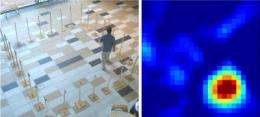Radio waves 'see' through walls (w/ Video)

University of Utah engineers showed that a wireless network of radio transmitters can track people moving behind solid walls. The system could help police, firefighters and others nab intruders, and rescue hostages, fire victims and elderly people who fall in their homes. It also might help retail marketing and border control.
"By showing the locations of people within a building during hostage situations, fires or other emergencies, radio tomography can help law enforcement and emergency responders to know where they should focus their attention," Joey Wilson and Neal Patwari wrote in one of two new studies of the method.
Both researchers are in the university's Department of Electrical and Computer Engineering - Patwari as an assistant professor and Wilson as a doctoral student.
Radio 'Eyes' to the Rescue
Patwari says the system still needs improvements, "but the plan is that when there is a hostage situation, for example, or some kind of event that makes it dangerous for police or firefighters to enter a building, then instead of entering the building first, they would throw dozens of these radios around the building and immediately they would be able to see a computer image showing where people are moving inside the building."
"They are reusable and you can pick them up afterwards," he says.
The technique cannot distinguish good guys from bad guys, but at least will tell emergency personnel where people are located, he adds.
Patwari says radio tomography probably can be improved to detect people in a burning building, but also would "see" moving flames. "You may be able to look at the image and say this is a spreading fire and these are people," says Patwari.
Wilson believes radio imaging also could be used in "a smarter alarm system. … What if you put radios in your home [built into walls or plugged into outlets] and used tomography to locate people in your home. Not only would your security system be triggered by an intrusion, but you could track the intruder online or over your phone."
Radio tomography even might be used to study where people spend time in stores.
"Does a certain marketing display get people to stop or does it not?" Wilson asks. "I'm thinking of retail stores or grocery stores. They spend a lot of money to determine, 'Where should we put the cereal, where should we put the milk, where should we put the bread?' If I can offer that information using radio tomographic imaging, it's a big deal."
Radio image tracking might help some elderly people live at home. "The elderly want to stay in their homes but don't want a camera in their face all day," Wilson says. "With radio tomographic imaging, you could track where they are in their home, did they get up at the right time, did they go to the medicine cabinet, have they not moved today?"
Wilson says a computer monitoring the radio images might detect an elderly person falling down the stairs based on the unusually fast movement.
He says radio tracking also might be a relatively inexpensive method of border security, and would work in dark and fog unlike cameras.
Another possible use: automatic control of lighting, heating and air conditioning in buildings, says Wilson. Radio tracking might even control sound systems so that the best sound is aimed where people are located, as well as noise cancellation systems which could be aimed automatically at noise sources, Patwari says.
More information:
Publications on RTI
• J. Wilson and N. Patwari, "Through-Wall Motion Tracking Using Variance-Based Radio Tomography Networks", arXiv.org, Oct, 2009.
• J. Wilson, N. Patwari, Regularization Methods for Radio Tomographic Imaging, in Proc. of the 2009 Virginia Tech Wireless Symposium, Blacksburg, VA, June 2009
• J. Wilson, N. Patwari, Radio Tomographic Imaging With Wireless Networks, Tech Report, 16 Sep 2008
• Mobicom 2008 demonstration poster
Earlier PhysOrg.com story: Wi-Fi signals can see through walls
Source: University of Utah (news : web)


















